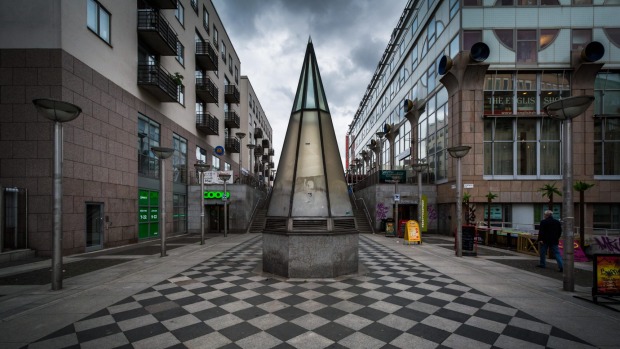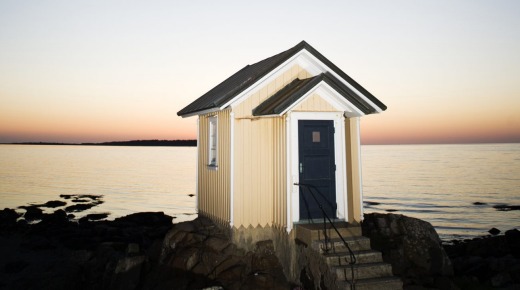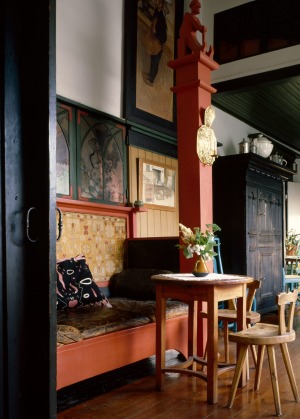
When I visited Carl Larsson's house in rural Sweden, he was long dead. Somehow, though, the presence of Larsson, his wife, Karin, and their seven children can be felt in the rambling house and garden.
It might have something to do with the exquisite watercolours Larsson produced depicting the family's life there. Or it might be due to the design of the place – not just the architecture, but the interiors, the textiles, the furniture arrangements. The very essence of the home, after all, is testimony to the central principles of Swedish design as we know it today.
The Larsson property is called Sundborn and it is light-filled and full of charming allure. The sense of careful design is not surprising, for Larsson is one of the country's most revered artists and we can learn a lot about him in the house, as well as in his autobiography Me, finished two days before he died in 1919. In his writing there is much about this rustic home, and his exquisite drawings in his books show how Sundborn embodies perfect functionality with gently seductive surfaces and colours.

It is always a pleasure to use something that has been designed well and, in Sundborn, it all seems to come together, from the textiles on the floor and furnishings to the placement of the chairs and beds to the way the windows have been set into the walls. It all moves together smoothly to make existing in this place easy, uplifting and happy. I wanted to move in.
When Larsson was alive, there was no IKEA, no Volvo and certainly no ABBA. And when we think of those things – or of H&M, Kosta Boda or Orrefors, Spotify, Nudie Jeans or Cheap Monday, Absolut Vodka, even the ubiquitous Baby Bjorn – we might not think of Larsson. But Swedish people tend to.
While he was not responsible for those famous brands, Larsson is among a clutch of thinkers and artists who are often cited as being crucially influential in the principles that have guided and defined Swedish design (though, perhaps ABBA's outfits is stretching it a bit).

But why did design blossom in this and other Scandinavian countries? Is it the cool climate? After all, if you're going to be swanning around indoors all the time, the eye and the mind are going to turn to the objects and environments around them.
Of course you're going to want to sit on nice furniture and eat with elegant spoons. You'll want functionality to merge with form in the best possible way, and you'll want your fish, potatoes, herrings, meatballs and green princess cake (a national favourite) to come served on smart crockery.
Fabrics: only bright gorgeous ones. Jewellery: ditto. And as for architecture: it's not all about external surfaces, is it? Divine interiors, please.
In the lanes of Sodermalm, the hippest island among the small landmasses that form central Stockholm, all of this can be seen. Design stores form a regular staple, breaking up the landscape of snazzy foodstores and apartment buildings, as clothing, furniture, jewellery and clever interior-design purveyors make their presence known not with the garish or the brazen, but with grace and subtlety.
Cruising these streets gives an insight to what is at the heart of Swedish design – a principle of elegant simplicity that might be expressed in the concept of "lagom". The word has no direct equivalent in English but alludes to a way of living that incorporates "just the right amount" of everything.
While it has a pragmatic context – it is, for example, considered vulgar to put too much on your buffet breakfast plate at the hotel, or to drive a ritzy car just because you have enough money to buy one, or to otherwise conspicuously display wealth, gluttony, pride, lust or envy – lagom also has a deeper philosophical resonance, echoed in the political success of the social democracy that has long guided the country.
Hence, there is a sort of gentle reserve in the culture (and the broad deployment of design) that is not at all unfriendly, but which gradually warms you the longer you are amid it.
For most Swedish people, lagom is also expressed in the concept of the summer house. Unlike the Australian notion of a holiday house – which tends towards the showy Grand Design end of things – the Swedish summer house is tiny, plain and often has only the basic necessities (which might or might not include electricity and running water). Most are no larger than a garden shed and are just an excuse to go rustic amid a vegetable plot and flowers. Usually a body of water is not too far away and, even on inner-city Sodermalm, rows of summer houses with fenced-in gardens amid greenery can be found along the banks, not far from busy shopping streets.
What is essentially Swedish about the design of a summer house is its marriage of something practical and democratic with streamlined beauty. Like Swedish design more broadly, it tends towards the use of natural materials and has a penchant for the sustainable. At its core, there is a feeling that design is not elitist: it is about a way of living that is good for the society as well as the individual. This, after all, is the country that no longer has landfills – everything is re-used in some way – and it is the place where social welfare is astonishingly progressive, from generous and gender-balanced parental leave arrangements to its attempts to make sure no-one falls through the net of being looked after. Those policies, too, are a matter of carefully thought-out design and lagom.
While the summer house has been around longer than anyone can remember, Sweden's distinct but hard-to-define design aesthetic first came to international attention at the World Exhibition of 1925 in Paris, and was initially noted in the realm of glassware. Since then, its fame has since extended into almost all fields of creative endeavour, from architecture – emphasising human scale and needs – to the rugs we walk upon.
Names such as Bruno Mathsson, Jonas Bohlin and Josef Frank (furniture), Hans Hedberg (stonework), Sigurd Persson (decorative art) and the luminary Larsson are only a few of the most famous. All of them are different, but share some key impulses – though Lasse Brunnstrom writes in Swedish Design History that since it became incredibly popular in the 1950s, with another major resurgence since the 1990s, Swedish design's reputation for being low-key without excessive embellishment remains well-earned – but the view that it is homogenous (and thus a touch boring) has been greatly exaggerated.
Rather, Brunnstrom argues, there is a more variegated history to explore – and when I visit Stockholm's inner-city island of Skeppsholmen, this becomes apparent. Not far from the dramatic cliffs of Sodermalm, this little island is a green paradise and has transformed itself from a naval base to Stockholm's cultural epicentre, with museums devoted to art, architecture and photography.
Its name refers to its boat-building history, but the jewel today is the Moderna Museet, a gorgeously simple building housing the country's best modern art collections and, in an adjoining wing, the Museum of Architecture, whose (of course) beautifully designed displays chart milestones in the country's dwellings. Likewise at the National Museum, on another island not far away, there is a permanent exhibition showing the major movements of 20th- and 21st-century design, including postmodern furniture, folk work and industrial items.
In other parts of the city, there are dozens of stores flogging distinct brands of Swedish design, from the high-end Kosta Boda or Ten Swedish Designers to the more earthy Beyond Retro (which sells newly designed creations stitched together with old materials, alongside well-preserved retro clothing). There's also Svenskt Tenn (textiles), Design House Stockholm (kitchenware, furniture), Tjallamalla (250-plus clothing designers), Granit (homewares) or Bookbinders Design (stationery).
But it is at the Design Torget in the heart of town near the pedestrian mall parading Stockholm's busiest retailers that everything comes together. Established in 1993 in a bid to support young designers, it has become a hothouse of creativity, a cultural centre where jewellery, ceramics, metalwork and household goods by both new and established designers can be found.
And who can ignore IKEA? This year will see the re-opening of the IKEA Hotel and Restaurant in the suburb of Almhult, where the company was founded in 1943. The hotel opened in 1964 but has been undergoing a massive refurbishment, and in the basement, visitors will be able to take in the IKEA Museum, showing highlights from its long and popular reign. I'd be intrigued to know what Carl Larsson would have thought of the place and of IKEA itself. Would he have loved the way its simple, democratic designs have been embraced? After all, about 10 per cent of all Europeans are believed to have been conceived on an IKEA mattress, a rate that is presumably much higher in Sweden. It must, like the Swedish way of thinking about lagom, be the result of good design.
visitsweden.com
Stockholm's Tunnelbana metropolitan train system is fast, efficient and impressively regular, with most trains arriving within a few minutes. The inner city, including Sodermalm, is eminently walkable, with Gamla Stan, the historic district, having mostly car-free pedestrian streets. Trains run from Stockholm's central station to Falun, 15 kilometres from Sundborn, 12-14 times daily. By car from Stockholm, it is a three-hour trip. See clg.se/
Hotel Point is a muted contemporary site with small, functional but impeccably clean rooms. The buffet breakfast is excellent. Ostgotagatan 65; see hotelpoint.se/
One of the most wonderful things about the spectacularly successful new photography museum Fotografiska is not the excellent collection and at least four big shows a year – think Annie Liebovitz or Nick Brandt – nor is it the great cafes and entertainment on-site. No, it's that the huge complex is open 9am-11pm daily.
See fotografiska.eu
Fika – the national pastime involving coffee or tea with a piece of cake happens at least once daily. The cakes at Konditori Lyran, in an old summer villa built in 1867 that overlooks Lake Malaren, are splendidly rich and visitors lounge around the sumptuous rooms or on the grass outside.
See konditorilyran.se
Rosendals is an open garden with a spectacular cafe and bakery, presenting biodynamic garden cultivation to the public. Set in and around several gorgeous greenhouses, the place also has lectures, courses, excursions and cooking classes. The setting is great: Djurgarden Island.
See rosendalstradgard.se
An archipelago boat trip is essential when visiting Stockholm – and the Fjaderholmarna (Feather islands) are the closest group to the city, only 25 minutes away by water. It's a lovely ride, and while there are the usual touristy handicrafts to contend with on the islands, the main point (if it's hot) is to go swimming.
See fjaderholmarna.se
Drottningholm Palace is the best preserved palace in the country – and it was built in the 1600s. Very French in flavour, its beautiful setting includes an exotic Chinese Pavilion pleasure palace, the palace theatre and magnificent gardens. One wing is reserved for the Royal family.
See kungahuset.se